Sampling of solids
Henk Lingeman, Free University, Free University, NetherlandsAbstract Sample preparation for solid samples frequently is more demanding then for gases or liquids. This because first of all the sample must be solubilized. Sometimes the sample is easily dissolved and then ready for injection or further pretreatment. In other cases the sample matrix is insoluble in common solvents, and the analytes must be extracted. Sometimes the analytes are not easily removed from an insoluble matrix because of inclusion or adsorption effects and special techniques like Soxhlet extraction, SPE, ultrasonication or microwave-assisted extraction are necessary.
LevelBasic
Sampling of sediment and soil
Sediment samples can be taken by using a Day or van Veen grab or by using a box-corer of gravity corer. Grabbers are used in case only the upper layer of the sediment must be samples, while the box-corer is used when deeper layers of the sediment must be samples. Although it is relatively easy to use a grabber, a number of precautions must be taken, because by the influence of sea water, for example, oxidation of the iron of the grabber can occur. Samples must be taken with a clean spatula or shovel - made of metal for organic compound and made of a polymer material for metals – from the center of the grab sample. Normally sediment samples are rather heterogeneous; this means that before subsampling can be performed the gross sample must be homogenized carefully. Repeated analyses of every sample in every batch must be performed to check the homogeneity of the sample.
The guideline for taking solid samples from non moving systems is that the minimum amount (in kg) of samples is about 0.05 times the size of the largest particle (in mm). In addition it is more important to take samples at various locations than to sample continuously at the same location.
Soil samples can be taken in several ways. The Most frequently approach is drilling a hole till the required depth is reached. Thereafter, the sample is removed from the drill and analyzed. Problems that can arise with this sampling technique are that the structure and the consistency (i.e. percentage of moisture) can be altered during the drilling process. It will be obvious that cleaning of the drill, after every sampling procedure, is a necessity. This method cannot be used in case detailed information about the structure of the soil is needed.
Soil samples can be treated in several ways. For example, for the determination sulfonylurea herbicides using LC, the soil samples can be mixed with a sodium bicarbonate solution. The resulting suspension is subsequently vibrated in an ultrasonic bath and centrifuged. The water phase can be decanted in the next step, and the extraction is repeated two more times. Finally, the remaining solid material (e.g. plant residues) can be removed via a filter and after acidifying of the combined extracts a suitable clean-up step can be performed. The determination of optical whiteners in the sediment of sewage treatment plants can be performed by freeze-drying samples of about 50 mL, homogenize the sample in a coffee mill, and finally storage at 40C.
However, it is not always possible to treat the samples in such an easy way. A solution is to destruct (digest) the sample by adding concentrated acids. For the determination of non-metal elements in organic samples combustion techniques can be used. The compounds to be determined are transferred to gaseous compounds which are collected in a suitable solvent. A simple approach is using the Schöninger combustion flask. In this approach the sample is burned in excess oxygen, and is used to determine C, H, N, S and halogens in organic compounds.
Schoninger combustion process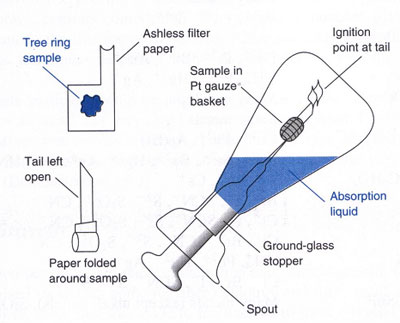
In this procedure 10 – 100 mg samples are used. The Pt gauze basket helps to obtain a complete combustion of the sample, which is carried out behind a blast shield. Ashless filter paper is a special grade that leaves little residue when it is burned. Prior to analysis of the sample, the filter can be washed several times with distilled water to remove traces of chloride and sulfate, as indicated in the tree ring example of this illustration.
Preliminary processing steps
However, before sample processing or extraction techniques can be applied normally first of all some preliminary processing (e.g., reducing particle size, drying, filtration) should be performed. A first step is reducing of the particle size of the sample. This because finally divided samples are more homogeneous, which means that a more representative sampling with a better accuracy and precision is possible. In addition smaller particles dissolve faster and are easier to extract because of a greater surface area. An overview of the methods that can be used to reduce the sample particle size is given in Table 8.
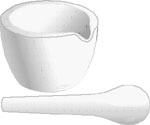 Grinding with a mortar and pestle is recommended for many solid samples and most of them will withstand the thermal rigor or grinding. If the sample contains thermally labile or volatile compounds, it is important to minimize heating during the grinding process and in case the sample is very hard, a diamond mortar equipped with a cylinder of hardened steel may be required. The grinding is performed by a close-fitting steel rod which fits inside the cylinder and the sample is pulverized by hammering on the rod.
Grinding with a mortar and pestle is recommended for many solid samples and most of them will withstand the thermal rigor or grinding. If the sample contains thermally labile or volatile compounds, it is important to minimize heating during the grinding process and in case the sample is very hard, a diamond mortar equipped with a cylinder of hardened steel may be required. The grinding is performed by a close-fitting steel rod which fits inside the cylinder and the sample is pulverized by hammering on the rod.
The grinding of samples is not as simple as it looks like. For example, samples should not be grinded as finely as possible because very fine powders are more likely to be contaminated from the large amount of handling. They also can be hard to handle and transfer, since they behave like dust. In addition samples should contain large numbers of particles for two reasons:
- The variation in content between individual samples will be minimized in this way and
- Each sample will be more representative of the bulk material.
Several factors can change the composition of the sample during the grinding process. The generated heat can result in sample losses of volatile components, while the larger surface area will facilitate reaction with the atmosphere (e.g. water). This means that the water content of a sample can be changed significantly by the grinding process.
| Method | Description |
| Blending | Mechanical blender chops a semi-soft substance into smaller parts; can also refer to the blending of a non-homogeneous sample into a more consistent form |
| Chopping | Mechanically cutting a sample into smaller parts |
| Crushing | Tungsten carbide variable jaw crushers reduce large, hard samples to 1- to 15-mm diameters |
| Cutting | Cutting mills can reduce soft-to-medium hard materials (< 100 mm diameters) by using rotating and stationary cutting knives; reduced size depends on sieves used in combination with mill |
| Grinding | Mortar and pestle most popular; mechanical mortar grinders automate and standardize grinding to analytical fineness done manually with a mortar and pestle; both wet and dry grinding are used; fineness of approximate 10-mm diameters can be achieved |
| Homogenizing | Making a sample more uniform in texture and consistency by breaking down into smaller parts and blending |
| Macerating | Breaking down a soft material into smaller parts by tearing, chopping, cutting, etc. |
| Milling | Disks mills pulverize < 20-mm-diameter hard samples by feeding between stationary and rotating disks with adjustable gap settings; generally reduced to 0.1 mm in diameter. Rotor-speed mills combine impact and shearing processes to grind soft-to-medium hard and fibrous materials down to 0.08 mm; ball mills grind material to submicron fineness by developing high grinding energy via centrifugal or planetary actions using agate, tungsten carbide, or PTFE-coated stainless steel balls; a soil mill will gently pulverize dried samples of soils, sludges, clays, and similar material by rotating nylon brushes that throw a sample against a chamber wall |
| Mincing | Breaking down a meat or vegetable product into smaller parts by tearing, chopping, cutting, dicing, etc. |
| Pressing | Generally refers to squeezing liquid from a semi-solid material (e.g., plants, fruits, meat) for the purposes of further analysis |
| Pulverizing | Electromechanically driven rod or vibrating base is used to break particles down mechanically into smaller units; can be performed in wet or dry state; freezer mill can be used with liquid N2 to treat malleable samples |
| Sieving | Passing a sample through a metal or plastic mesh of a uniform cross-sectional area (square openings from 3 mm to 123 mm) to separate particles into uniform sizes; both wet and dry sieving can be used |
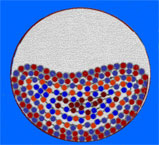 Dealing with soft materials a ball mill is recommended. Here the samples are placed into a porcelain cylinder containing porcelain, stainless steel, or hard flint balls. After the cylinder is sealed, it is rotated, shaken, or vibrated until the material inside is ground into a finely divided state. The resulting material may then be sieved to achieve a more homogeneous sample.
Dealing with soft materials a ball mill is recommended. Here the samples are placed into a porcelain cylinder containing porcelain, stainless steel, or hard flint balls. After the cylinder is sealed, it is rotated, shaken, or vibrated until the material inside is ground into a finely divided state. The resulting material may then be sieved to achieve a more homogeneous sample.
Malleable or elastic samples such as rubber or plastic must be cooled before grinding to make them brittle. For this, dry ice can be added directly to a mortar or ball mill. The dry ice should be prepared from carbon dioxide that is free from impurities that might contaminate the sample. When lower temperatures are required to solidify the sample, pulverizing the sample under liquid nitrogen can be carried out in a freezer mill or cryogenic pulverization system.
In solid samples in many cases water is present. This water can be either essential or non-essential water.
- Essential water forms an integral part of the molecular or crystalline structure of an analyte. An example is the water that is present in a hydrate (e.g., CaC2O4.2H2O). In addition, to hydrate the water of constitution is the water found in analytes that yield stoichiometric amounts of water when heated or otherwise decomposed. An example is the water found in potassium hydrogen sulfate {2KHSO4 (s) D K2S2O7 (s) + H2) (g)}.
- Non-essential water is the water retained by the analytes by physical forces and which is not necessary for the characterization of the composition of the analyte. Non-essential water can be divided in adsorbed water (retained on the surface of the solid), sorbed water (encountered with colloidal substances) and occluded water (entrapped in microscopic pockets). The amount of (ad)sorbed water depends on the temperature and the humidity. Since occluded water is not in equilibrium with the atmosphere it is not sensitive for changes in the humidity.
Solid samples are often received for analysis in a damp or wet state. Removal of water or drying the sample to constant weight is usually necessary for a reliable assay. Inorganic samples such as soil should be heated at a temperature from 1000 – 1100.0C to ensure the removal of moisture. Drying by using microwave irradiation, nowadays also is a suitable option. Hydrophobic organic samples seldom re-quire heating, since water absorption is minimal. Organic vapors can also be adsorbed by solid organic samples, and a heating step can remove these contaminants. For hygroscopic samples, drying in a vacuum desiccator is recommended.
Samples that can oxidize when heated in the presence of air should be dried under vacuum or nitrogen. Biological samples generally should not be heated to above 1000C, and temperatures above ambient often should be avoided to avoid sample decomposition. Sensitive biological compounds (e.g., enzymes) often are prepared in a cold room at less than 40C to minimize decomposition.
Freeze-drying (lyophilization) often is used to preserve the integrity of heat-sensitive samples (especially biologicals). The is carried by quick-freezing the sample, followed by removal of frozen water using sublimation under vacuum.
Techniques for sampling of solids
Traditional extraction methods for solid samples are: solid-liquid extraction, Soxhlet extraction, forced-flow leaching, homogenization, sonication and dissolution. Modern techniques for solid samples include: accelerated solvent extraction, supercritical-fluid extraction, microwave-assisted extraction, thermal extraction.
- In solid-liquid extraction the sample is present in a closed container and a solvent that is able to dissolve the analyte(s) is added. The solvent is normally boiled or refluxed to increase the solubility. Filtration, decantation or centrifugation can be used to separate the remaining insoluble particles from the dissolved fraction. To improve the efficiency the sample should be divided into small particles.
- One of the eldest tools for the sampling of solids is Soxhlet extraction.
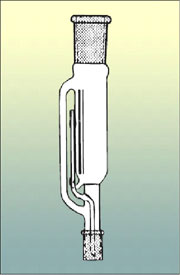 In this case the sample is placed in a disposable porous container, called thimble, and
In this case the sample is placed in a disposable porous container, called thimble, and 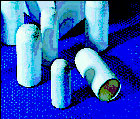 by continuous refluxing an organic solvents flows through the thimble and dissolves the analyte molecules. A prerequisite for a proper extraction is that the sample is stable in the boiling solvent. The main limitation is that it is a relatively slow process, but on the other hand the system can be easily automated. The best results are obtained for finely divided particles.
by continuous refluxing an organic solvents flows through the thimble and dissolves the analyte molecules. A prerequisite for a proper extraction is that the sample is stable in the boiling solvent. The main limitation is that it is a relatively slow process, but on the other hand the system can be easily automated. The best results are obtained for finely divided particles. - A relatively simple approach is homogenization of the sample. A finely divided sample is homogenized with a solvent, which can be removed during a subsequent ST step. This approach can be applied for a wide variety samples in combination with both aqueous and non-aqueous solvents. Dry-ice, diatomaceous earth or lyophilization can be used to facilitate the process.
- A relatively effective approach is the immersing of a finely divided sample in an ultrasonic bath. Ultrasonic radiation, an ultrasonic probe of ultrasonic cell disrupter can be used to dissolve samples. The ultrasonic process just is another way to add energy (i.e. heat) to a sample to facilitate the dissolution.
- The simplest approach is dissolution. In this case the sample is treated with a suitable solvent and without any chemical or physical the changes the sample is dissolved. The dissolution process normally can be accelerated by heating of the sample. In the case of acids, bases or amphoteric compounds adaptation of the pH can facilitate the dissolution.
- In addition to these more traditional techniques there a few relatively new approaches. One of these is accelerated solvent extraction (ASE). The sample is placed with a suitable solvent in a sealed container and heated above its boiling point. The will result in an increase of the pressure in the container. ASE significantly enhances the speed of the extraction because of the increased pressure and temperature. The extracted sample is automated extracted and can be further analyzed after a final concentration step.
- Another recent development is the use of microwave assisted extraction (MASE). The sample is present in an open or in a closed container and the energy needed to dissolve the samples is generated by means of a microwave. The extraction can be performed in two modes: the microwave-absorbing (MA) and the non-microwave absorbing (NMA) mode. The choice of the extraction solvent is rather critical in all cases. In the MA mode the sample is placed in a high-pressure non-microwave absorbing container and heated well above its boiling point. In this mode the sample and the solvent can be refluxed at atmospheric pressure. In the NMA mode no pressure increase is needed.
- A comparison of extraction methods for the sampling / initial ST of solids is given in Table 9 (Click here to enlarge)
| Parameter | Sonication | Soxhlet | Soxhlet | SFE | ASE | MASE | MASE |
| Sample size, g | 20-50 | 10-20 | 10-20 | 5-10 | 5-15 | 2-5 | 2-10 |
| Solvent volume, ml | 100-300 | 200-500 | 50-100 | 10-20 | 10-15 | 30 | 20-30 |
| Temperature, 0C | Ambient-40 | 40-100 | 40-100 | 50-150 | 50-200 | 100-200 | Ambient |
| Pressure | Atmospheric | Atmospheric | Atmospheric | 2000-4000 psi | 1500-2000 psi | 1500-2000 psi | Atmospheric |
| Time, h | 0.5-1.0 | 12-24 | 1-4 | 0.5-1.0 | 0.2-0.3 | 0.2-0.3 | 0.1-0.2 |
| Degree of automation | 0 | 0 | ++ | +++ | +++ | ++ | ++ |
| Number of samples | High | 1 | 6 | 44 | 24 | 12 | 12 |
| Costs | Low | Very low | Moderate | High | High | Moderate | Moderate |





